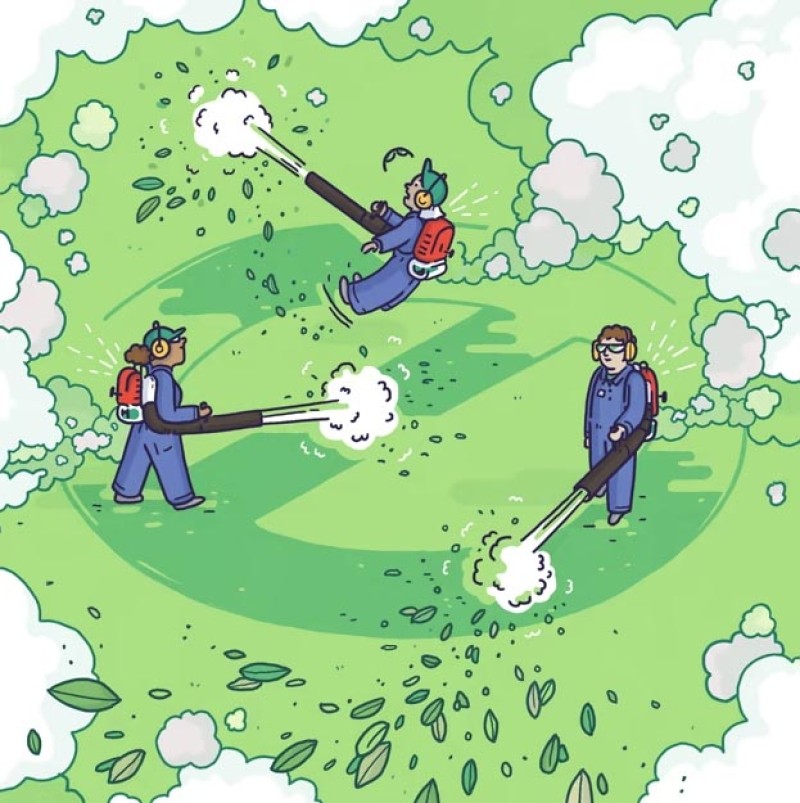How a small group of activists (our correspondent among them) got leaf blowers banned in the nation’s capital
For a long time I thought the problem was all in my head. When I was growing up, I knew that a certain kind of noise was one I needed to avoid. Food blenders in the kitchen, hair dryers in the bathroom, a vacuum cleaner whooshing around—all produced an intense whining sound that, given the specific wiring connections between my ears and my brain, kept me from thinking about anything but the sound itself while it was going on. Over the years I lived by this code: I used high-performance earplugs if I needed to write or otherwise concentrate while sitting in some place that was unusually loud. I added noise-canceling headphones on top of the earplugs in really tough cases.
As time went on, the earplugs-plus-headphones protection rig became standard writing gear. That was because the use of gas-powered leaf blowers in my Washington, D.C., neighborhood evolved from a few hours a week during the leafiest stretch of autumn to most days of the week, most weeks of the year, thanks to the advent of the “groomed” look that modern lawn crews are expected to achieve. One of my longest-running themes as a journalist has been how changes in technology force people to adapt their habits and livelihoods. I thought I was doing my part, with gear that let me attend to my work while others attended to theirs. There even turned out to be a bonus: As other parts of my body went into a predictable age-related descent, my hearing remained sharp.
Then I learned several things that changed my thinking both about leaf blowers and, up to a point, about politics.
One thing I learned has to do with the technology of leaf blowers. Their high volume, which I had long considered their most salient feature, is only their second-most-unusual aspect. The real marvel is the living-fossil nature of their technology. And because the technology is so crude and old, the level of pollution is off the charts.
When people encounter engines these days, they’re generally seeing the outcome of decades of intense work toward higher efficiency. The latest models of jet-turbine engines are up to 80 percent more fuel-efficient than their 1950s counterparts. While power plants burning natural gas obviously emit more carbon than wind or solar facilities, they emit about half as much as coal-fired plants. Today, the average car on America’s streets is almost 200 percent more efficient than in 1950, and smog-causing emissions from cars are about 99 percent lower.
In California, gas-powered leaf blowers and similar equipment could soon produce more ozone pollution than cars do.
The great outlier here is a piece of obsolete machinery Americans encounter mainly in lawn-care equipment: the humble “two-stroke engine.” It’s simpler, cheaper, and lighter than the four-stroke engines of most modern cars, and has a better power-to-weight ratio. But it is vastly dirtier and less fuel-efficient, because by design it sloshes together a mixture of gasoline and oil in the combustion chamber and then spews out as much as one-third of that fuel as an unburned aerosol. If you’ve seen a tuk‑tuk, one of the noisy tricycle-style taxis in places such as Bangkok and Jakarta, with purple smoke wafting out of its tailpipe, you’ve seen a two-stroke engine in action.
Yet they remain the propulsive force behind the 200-mph winds coming out of many backpack leaf blowers. As a product category, this is a narrow one. But the impact of these little machines is significant. In 2017, the California Air Resources Board issued a warning that may seem incredible but has not been seriously challenged: By 2020, gas-powered leaf blowers, lawn mowers, and similar equipment in the state could produce more ozone pollution than all the millions of cars in California combined. Two-stroke engines are that dirty. Cars have become that clean.
So that’s one thing I learned about gas-powered blowers. A second thing I discovered is the damage leaf blowers do to people’s hearing. The biggest worry of today’s public-health community is not, of course, leaf blowers—it’s the opioid disaster, plus addictions of other forms. The next-biggest worry is obesity, plus diabetes and the other ills that flow from it. But coming up fast on the list is hearing loss. According to a 2017 report from the Centers for Disease Control and Prevention, one-quarter of Americans ages 20 to 69 who reported good to excellent hearing actually had diminished hearing. This is largely caused by rising levels of ambient urban noise—sirens, traffic, construction, leaf blowers—which can lead to a range of disorders, from high blood pressure to depression to heart disease. “When I started out, I’d see people in their 60s with hearing problems,” says Robert Meyers, an ENT specialist at the University of Illinois at Chicago. “Now I’m seeing them in their 40s.”




